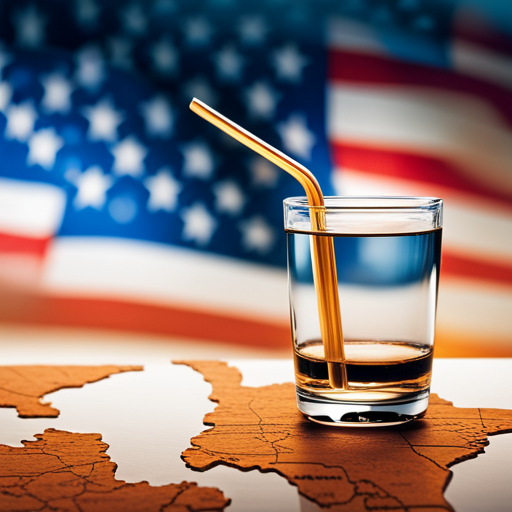Do you know if your state has the cleanest tap water in the US? Water quality is a crucial aspect of public health, and it varies widely across the country. Some areas have access to safe and clean drinking water, while others have issues that can pose serious health risks.
In this article, we will take a closer look at the states with the cleanest tap water in the US and the factors that affect water quality. You may be surprised to learn that some states have incredibly clean tap water. These states prioritize their water infrastructure and treatment methods to ensure safe drinking water for their residents.
However, other states face challenges such as aging infrastructure, pollution, and natural disasters that can lead to water quality issues. By exploring the best and worst tap water in the US, we can better understand the state of water quality in our country and what can be done to improve it.
Key Takeaways
– Hawaii, Alabama, and South Carolina have the best tap water in the US.
– Factors affecting water quality include geographical location and poorer, rural areas often having unsafe and poor-quality water.
– Some cities and states, such as Pensacola, FL; Milwaukee, WI; and Fresno, CA, have issues with water quality, including contaminants that can pose serious health risks.
– Overall, American water quality is generally very high, with some of the cleanest water in the world.
Top States for Clean Water
If you’re curious about which states have the cleanest tap water in the US, you’ll be happy to know that Hawaii, Alabama, and South Carolina are among the top states for clean water. Hawaii’s groundwater from volcanic rock is pure, while Alabama has an abundant supply of freshwater from rivers and streams. South Carolina relies on 80% surface water sources, which are closely monitored for contaminants.
These states’ water sources are carefully managed, and the impact of environmental regulations on water quality is evident. Water source comparisons show that the states with the cleanest tap water have strict regulations and invest in water management. Massachusetts, Rhode Island, and New Hampshire are among the states with the strictest regulations, which have led to high-quality drinking water.
Tennessee and Minnesota have a lot of surface water resources, which are tested frequently to ensure safety. Connecticut delivers a combination of ground and surface waters, while Memphis, TN uses the Memphis Sand Aquifer, which produces the cleanest water in the US. These states’ efforts to regulate and manage their water sources have resulted in some of the cleanest tap water in the country.
Factors Affecting Water Quality
You may be interested to know that various factors can greatly impact the quality of the water you consume. For instance, the quality of water in rural areas is often poorer than that in urban areas due to a lack of proper infrastructure. Additionally, water treatment methods used by different states can also contribute to varying water quality levels.
Some states use advanced treatment methods, such as reverse osmosis, while others rely on more traditional methods like chlorination. Another factor that can affect water quality is climate change. Changes in precipitation patterns and rising temperatures can impact the availability and quality of water sources.
For example, droughts can lead to decreased water supply, while heavy rainfalls can cause runoff that carries pollutants into water sources. It is important to monitor and address these environmental changes in order to maintain the quality of our drinking water. By implementing proper treatment methods and addressing the impact of climate change on water quality, we can ensure that everyone has access to clean and safe drinking water.
Issues with Water Quality
Contaminants in public drinking water can pose serious health risks, and some areas in the US are facing significant issues with water quality due to various factors. Natural disasters, old infrastructure, treatment byproducts, industry and agriculture, human and animal wastes, and natural sources are the main causes of water contamination in some cities and states. The top three cities with the worst tap water are Pensacola, FL; Milwaukee, WI; and Fresno, CA.
To give you an idea of the gravity of the situation, here’s a table of the contaminants found in these cities’ tap water:
| City | Contaminants Found | Health Risks |
|---|---|---|
| Pensacola, FL | Radium, lead, benzene, carbon tetrachloride, and more | Cancer, liver damage, anemia, and more |
| Milwaukee, WI | Lead | Brain damage, developmental delays, and more |
| Fresno, CA | Arsenic, uranium, radium, and more | Cancer, kidney damage, and more |
It’s important to be aware of the state of your tap water and take precautions to ensure that it’s safe to drink. If you live in one of these cities or in an area with questionable water quality, consider investing in a water filtration system or using bottled water for drinking and cooking. Don’t take any chances with your health and the health of your loved ones.
Conclusion
Congratulations! Now you know which states have the cleanest tap water in the US. By considering the factors that affect water quality and addressing issues related to water infrastructure and treatment methods, these states have been able to provide their residents with safe and clean drinking water.
However, it’s important to note that many areas in the US still struggle with poor water quality. As a responsible citizen, you can take steps to ensure that your drinking water is safe. You can invest in a water filtration system or choose to drink bottled water if you have concerns about the quality of your tap water.
It’s crucial that we all take action to ensure that safe and clean drinking water is available to everyone in the US.




